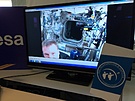Wednesday shook an astronaut aboard the International Space Station, the hand with a telerobotica specialist on the ground in the Netherlands. The astronaut tested a joystick that will make it possible for astronauts to see objects at a distance, to “feel”.
That writes the ESA on its website. The astronaut, Terry Virts, shook at 21:10 Wednesday night through the Haptics 2 at a distance the hand of André Schiele, a specialist in telerobotica. A blog describes the precise actions in detail. The joystick is identical in both, and every movement is exactly copied between the two locations.
The feedback of the joystick was adjusted so that the users the power of the other to be able to feel when to push or to pull. The test is not just carried out. The goal is, eventually, astronauts in orbit around Mars to get in a spacecraft and that they in that way, robots on the surface can operate. To have robots as precise to be able to serve the astronauts in the neighborhood of Mars, because it’s from the earth is about twelve minutes before a radio signal is sent back and forth and that makes not a sense of interaction.
The test Wednesday was to check whether the communications network, the technology for the joysticks to steer and the software all working properly and worked as expected. Each signal had to go between the ISS and the headquarters of the ESA-ESTEC in Noordwijk, via another satellite about 36,000 kilometres above the earth, and the Houston Mission Control Center in the United States. That lasted until a maximum of 0.8 seconds.
The ISS runs itself with 28.800 km per hour to the earth, causing the end point of the communication is ever-changing. The system is designed to automatically correct for that constant minor differences in time. In addition to the joystick had Virts on the ISS to a screen with a real-time video with an arrow that augmented reality added to the whole: the arrow indicated the direction and the size of the force was.
The next test will be a blind test to see if it is possible to various objects made of foam apart to see if a man who is in the room, so difference can feel in the stiffness of an object. This is important for sophisticated tasks in the future.
The next experiment is planned for september this year. Another still ongoing project, Haptics-1, has already shown that people stiffness and torsion differently. That means that people power, and combinations of position and force using their hands and arms differently in space than on the ground. That is very important to understand how someone will feel and experience.
Update 5 June 20.26: Friday released video added.
